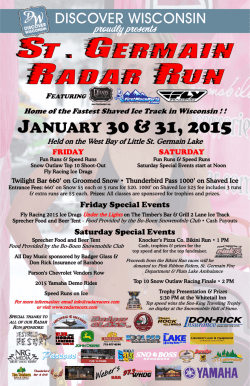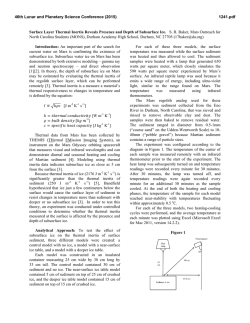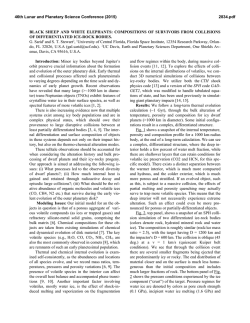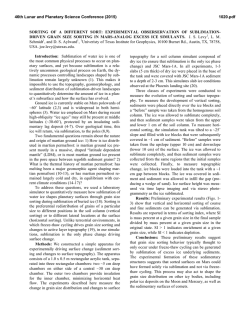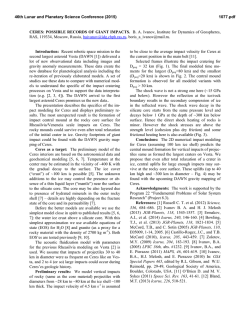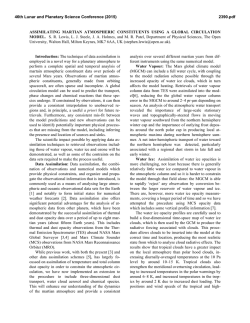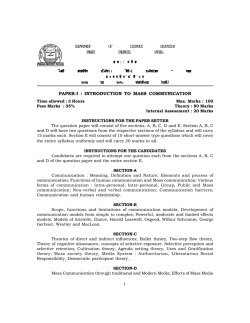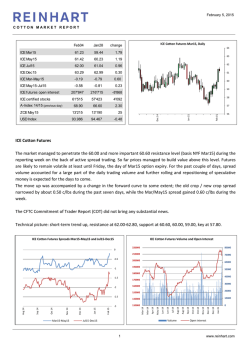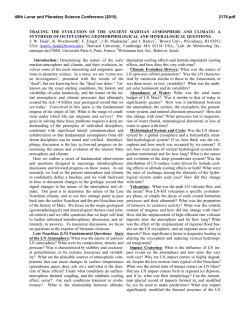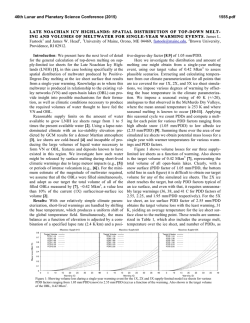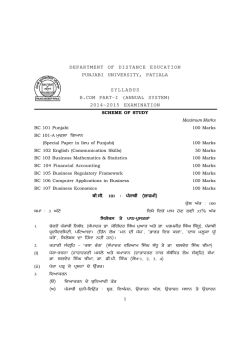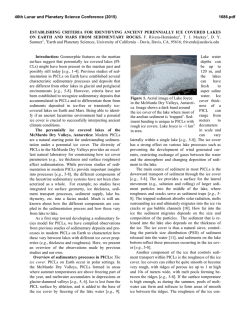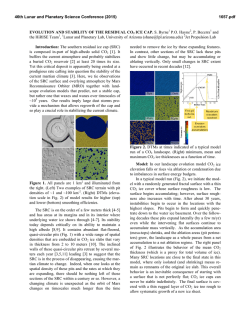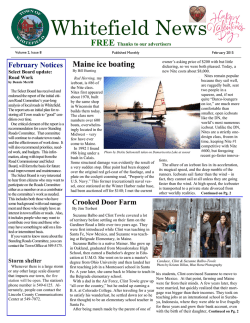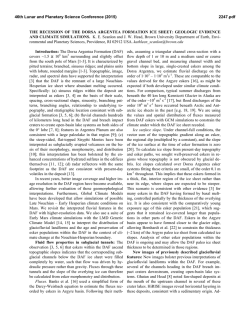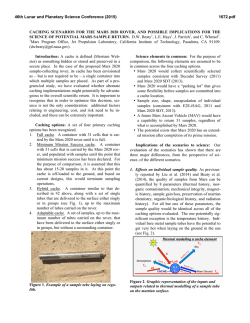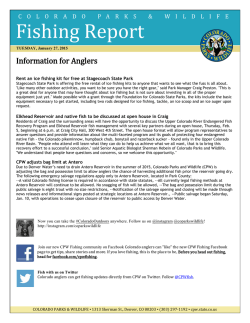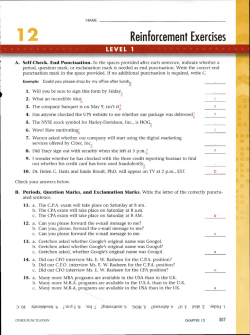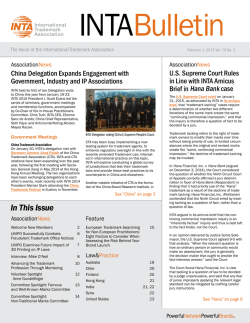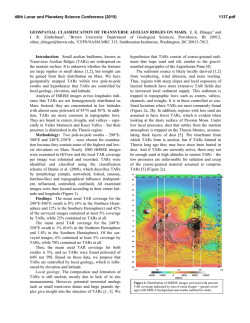
CURVILINEAR FURROWS ON MARS: HINTS FOR ICEBERG
46th Lunar and Planetary Science Conference (2015) 1349.pdf CURVILINEAR FURROWS ON MARS: HINTS FOR ICEBERG RAFTING? Esther R. Uceda1, Alberto G. Fairén2, Christoper Woodworth-Lynas3, J. Alexis P. Rodríguez4. 1 Universidad Autónoma de Madrid, 28049 Madrid, Spain ([email protected]); 2Centro de Astrobiología, 28850 Madrid, Spain (agfairen@ cab.inta-csic.es); 3PETRA International Ltd., Newfoundland & Labrador, Canada A0A 2B0; 4NASA Ames, 94035 Moffett Field, CA, USA. Identification of curvilinear furrows: In past years, we presented evidence for dump structures and chains of craters that we interpreted as indication for iceberg transport and grounding on very cold oceans on early Mars [1]. Here we add the identification on HiRISE images of curvilinear furrows which can be observed in the Hellas Basin (Figs. 1-3). All this data support the notion of the existence of frigid oceans/ lakes on a “cold and wet” early Mars [2,3]. lake-floor sediments [4,5]. Typical terrestrial scour marks are often several kilometers long, tens of meters wide and 0.5 to 5 meters deep [5] consistent with the dimensions of the furrows we describe here from the Hellas basin on Mars. Figs. 1-3: Scour marks (arrows) in Hellas Basin (HiRISE image PSP_009548_1420). Scale bars = 1 km. HiRISE image credit: NASA/JPL/University of Arizona. The furrows are located in elevated areas or on local topographic highs. We interpret these features in terms of iceberg rafting and grounding. We propose that the furrows were formed in submerged unconsolidated sediments, when floating ice keels touched down and displaced loose material to the sides as they continued to move forward, possibly driven by both wind and water currents. Terrestrial sea ice and icebergs form scour marks when draft exceeds water depth and their keels touch and plough forward through unconsolidated ocean- or Importantly, evidence of upsteam glaciation in the form of lateral moraines, terminal moraines, till deposits, and kame and kettle topography is been recently recognized on Mars [6-8]. Therefore, evidence for mountain glacial activity required to fed the system is well preserved. Alternatives: Alternative formation processes for the curvilinear features on the surface of Hellas include: (1) Faults. Faults tend to maintain preferential orientations reflecting bedrock structural trends, and offsets would be expected where they intersect. Neither of these characteristics are observed in the HiRISE images of interpreted ice scour marks analyzed so far. Faults are thus rejected. (2) Fractures/joints. Like faults, fractures and joints tend to reflect preferential bedrock structural trends, and may occur in linear intersecting groups with little or no offset at the intersection points. Strong trends that could be related to bedrock structure are not seen in the images of proposed ice keel scour features, and the meandering, curvilinear nature of many marks are evidence against bedrock control. Fractures and joints are thus excluded. 46th Lunar and Planetary Science Conference (2015) (3) Collapsed lava tubes. These are generally long, meandering features that do not usually occur in intersecting groups. They tend to be much wider and deeper than the proposed scour marks, and typically do not have raised rims. Collapsed lava tubes are thus excluded. (4) Dust devil marks. Meandering dust devil tracks are common features over a wide range of latitudes in both hemispheres of Mars. The tracks have no morphological surface expression unlike scour marks. Also, the tracks have been observed in the process of formation from orbit. Dust devils are thus rejected as the formative process. Previous studies: Using MGS data, Ormö and Komatsu [9] also found curvilinear grooves in places in Hellas basin, and they interpret some of them as possible ice keel scour marks. Fossil ice floes up to 45 m thick have been recognized and documented in the Cerberus Fossae region [10]. Findings from radar profiles indicate these features are between ~50 – 150 m thick [11]. The floes are not associated with ice scour marks and grounding pits because such features would be hidden from view below the fossil ice canopy. Rice et al. [12] investigated platey and ridged terrain at the mouths of Athabasca and Marte Valles, in Elysium Planitia. They interpret platey terrain as the fossil casts of former ice floes and ridged terrain as ice pressure ridges, emplaced by jökulhlaups (glacial outburst floods). Kettle cratering has also been proposed to have occurred in Athabasca Vallis [13]. Evidence of ice keel scour marks and ice floe grounding pits within the Kasei Valles system and parts of Echus Chasma has been reported [14]. Earth analogues: On Earth, ice scouring of lake and seafloor sediments by the keels of drifting ice masses is a common geological process on modern polar and temperate continental shelves (Fig. 4) and in seasonally frozen lakes and seas, such as the Great Lakes, Caspian Sea and alpine lakes [15]. Modern icebergs impact the seabed up to 350 m depth in terrestrial oceans, though during the Quaternary iceberg drafts reached extreme values of almost 1000 m [16]. The period of seabed interaction may last from a few minutes to several months [5]. Scour marks may survive the transition from submergence to exposure above water level, and ancient features are commonly seen, for example, over large areas of southern Manitoba and parts of southern Ontario formerly occupied by glacial Lake Agassiz and glacial Lake Iroquois [17]. They are also found on several large islands of the Arctic Archipelago (e.g. King William Island, Victoria island) and are readily identified from aerial photographs. These relic features were formed in large pro-glacial lakes and (in the 1349.pdf Fig. 4. Iceberg keel marks identified 70 miles offshore of Georgetown, South Carolina [21]. Arctic) areas formerly submerged below sea level some 10,000 years ago [18]. Scour marks preserved in Pre-Cambrian, Ordovician and Carboniferous/Permian age glaciomarine sediments have been identified on exposed bedding plane surfaces in several localities worldwide [19], and it is known that low sedimentation rates favor the preservation of scours [20]. An analogue to our interpretation of ice keel scour marks on Mars is the lengthy scientific debate over the origin of similar surficial curvilinear features on Earth. This debate was based largely on the two attributes common to both the Earth and the Mars interpretations, namely: (i) the interpretations are based on remotely sensed data (aerial photographs on Earth), and (ii) interpretations hinge principally on the significance of regional patterns and morphology of the features. The debate concluded with the now accepted interpretation of the terrestrial features as ice keel scour marks. References: [1] Fairén, A.G., et al., 41st LPSC, #2478 (2010). [2] Fairén, A. G. Icarus, 208, 165-175 (2010). [3] Fairén, A. G., et al. Nature 459, 401-404 (2009). [4] Thomas, G. S. P. & Connell, R. J. J. Sedim. Petrol. 55, 243-249 (1985). [5] Woodworth-Lynas, C. et al. Cont. Shelf Res. 11, 939–951 (1991). [6] Davila, A. F. et al. Geology 41, 755-758 (2013). [7] Fairén, A. G., et al. Nature Geoscience, 4, 667-670 (2011). [8] Kite E. S. & Hindmarsh, R. C. A. Geophys. Res. Lett. 34, L19202, doi:10.1029/2007GL030530 (2007). [9] Ormö, J. & Komatsu, G. J. Geophys. Res. 108 doi:10.1029/ 2002JE001980 (2003). [10] Murray, J. B., et al. Nature, 434 352-256 (2005). [11] Orosei, R., et al. LPSC 39, #1866 (2008). [12] Rice, J. W., et al. LPSC 33, #2026 (2002). [13] Gaidos, E. & G. Marion. J. Geophys. Res., 108(E6), 5055 (2003). [14] Woodworth-Lynas, C. & J. Y. Guigné. Oceanography 16, 90-97 (2003). [15] Lewis, C. F. M., & Woodworth-Lynas, C. Geology of the Continental Margin of Eastern Canada, 2, 785-793 (1990). [16] Kuijpers, A., et al. Marine Geol. 246, 60-64 (2007). [17] County, E., & Ontario, E. Geographie physique et Quaternaire, 46(2), 189-194 (1992). [18] Woodworth-Lynas, C. & Guigné, J. Y. Geological Society, London, Special Publications, 53(1), 217-233 (1990). [19] Woodworth-Lynas, C. The geology of ice scour. Ph.D. thesis, University of Wales (1992). [20] Syvitski, J. et al. Arct. Antarct. Alp. Res. 33, 52–61 (2001). [21] Hill, J.C., et al., Geology 36, 447-450 (2008). Acknowledgements: The research leading to these results has received funding from the European Research Council under the European Union's Seventh Framework Programme (FP7/20072013), ERC Grant agreement no. 307496.
© Copyright 2026
